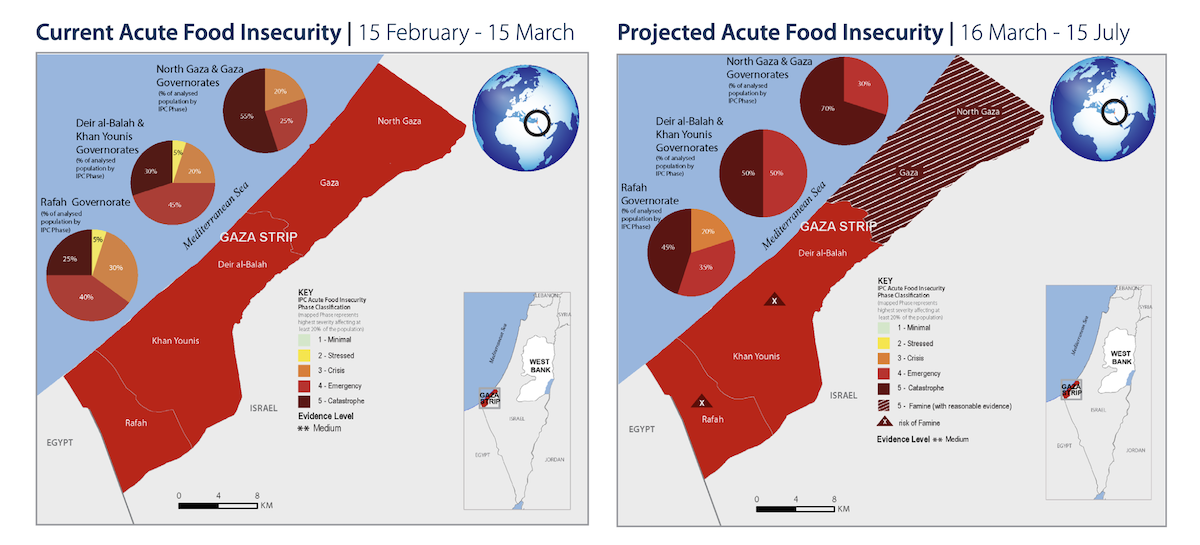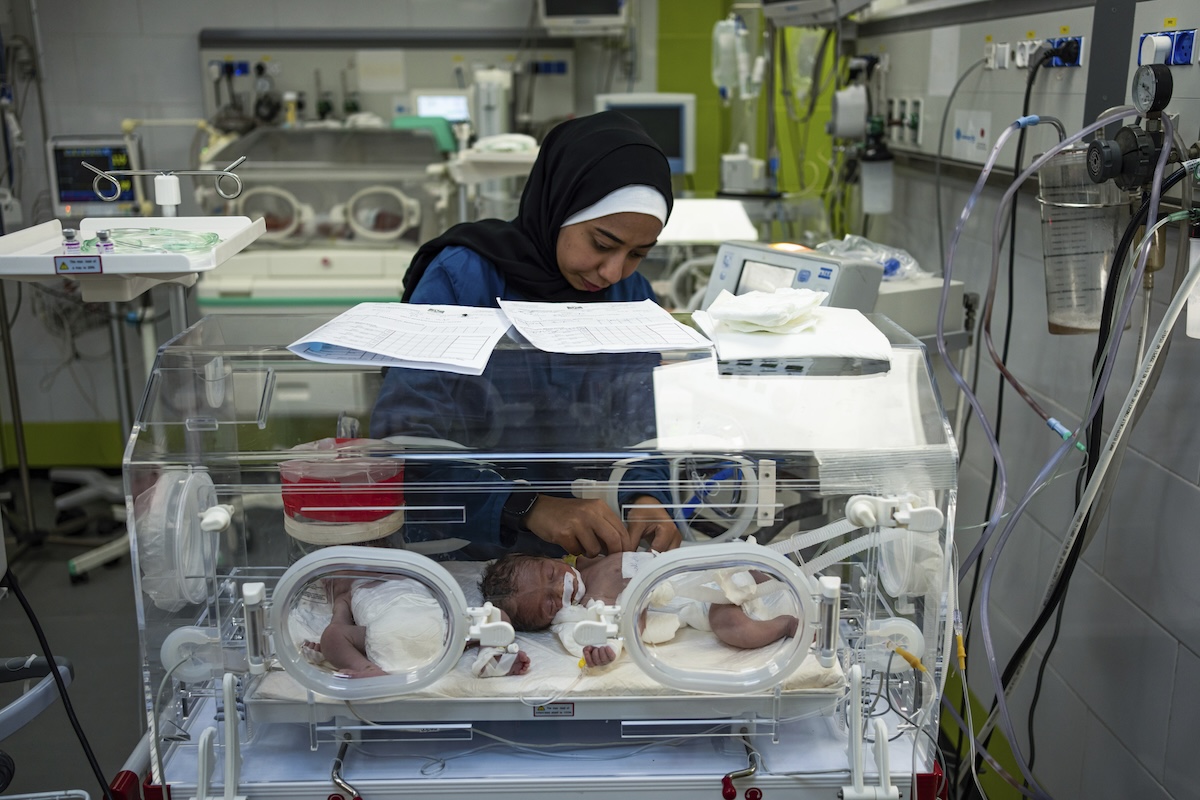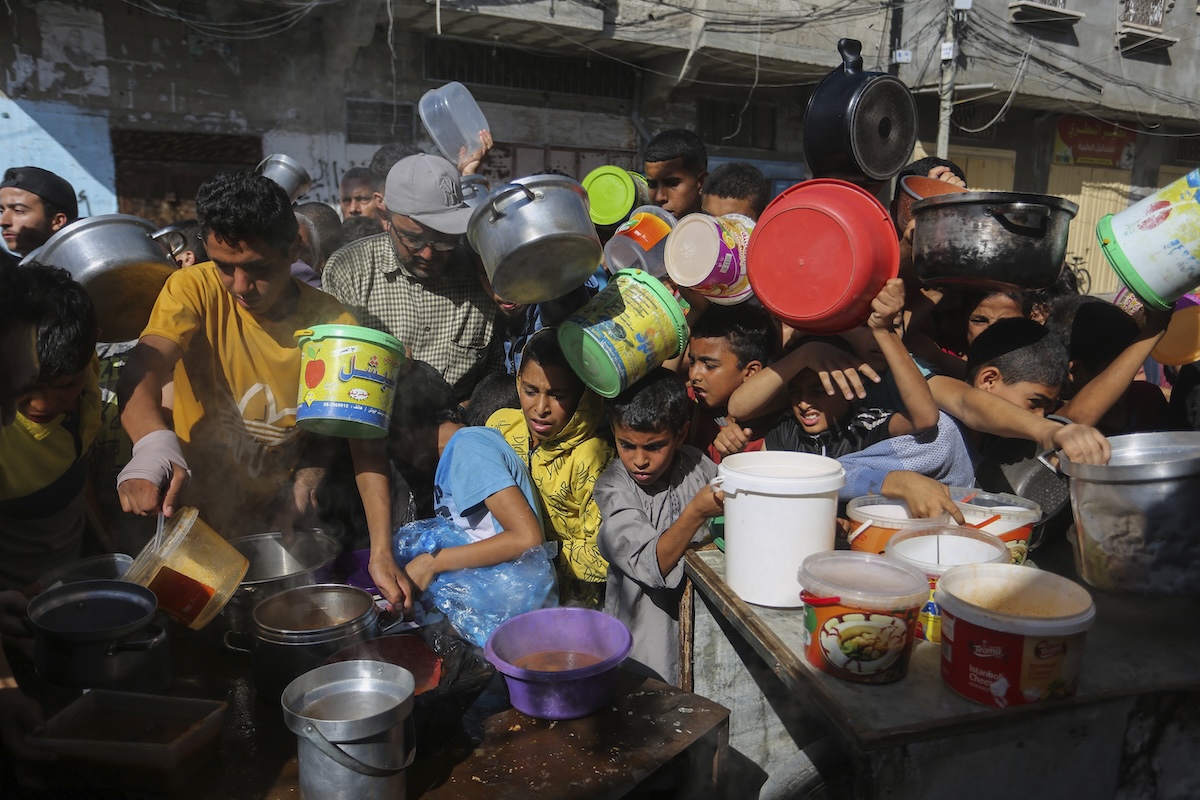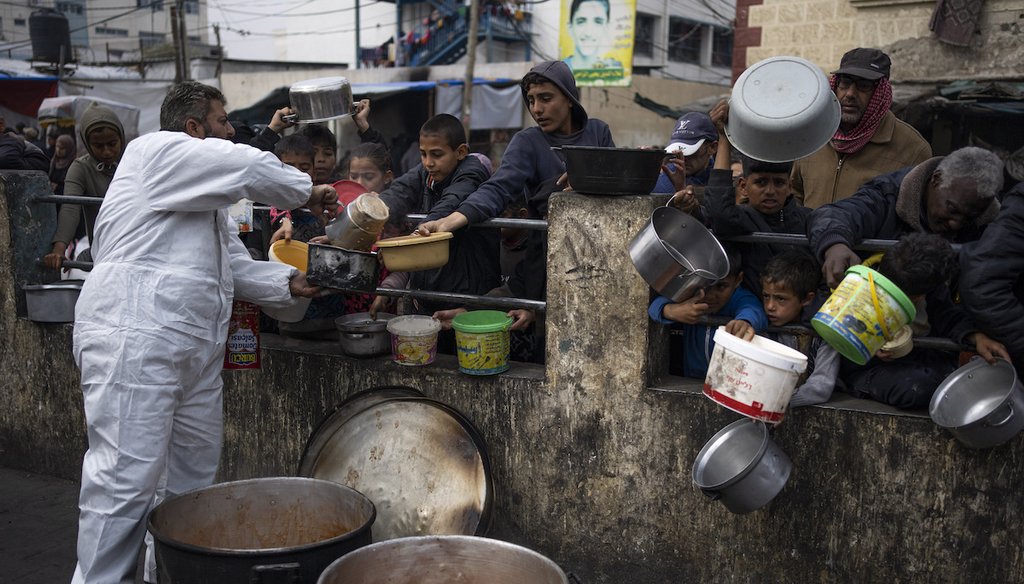

Our only agenda is to publish the truth so you can be an informed participant in democracy.
We need your help.


Palestinians line up for free food in Rafah, Gaza Strip, Feb. 23, 2024. (AP)
A March report compiled by organizations that evaluate global food emergencies said 677,000 people in Gaza face "catastrophic" food insecurity, based on the Integrated Food Security Phase Classification system.
We found no instances in which more people have been classified as experiencing "catastrophic" hunger or famine conditions in any one location since the 2004 creation of the tracking system.
The classification system is not used in all countries and sometimes the data used to track food insecurity is unavailable or incomplete.
Learn more about PolitiFact’s fact-checking process and rating system.
In Gaza, experts and journalists say, food is running out.
Some people are making "bread" from animal feed ground into flour or "soup" from water and weeds, according to news reports. But even those food sources are being exhausted, warned experts who evaluate food insecurity and famine.
"Palestinians in Gaza are enduring horrifying levels of hunger and suffering," United Nations Secretary-General António Guterres said March 18. "This is the highest number of people facing catastrophic hunger ever recorded by the Integrated Food Security Classification system — anywhere, anytime."
“Palestinians in Gaza are enduring horrifying levels of hunger and suffering” – UN Secretary-General António Guterres
— UN News (@UN_News_Centre) March 18, 2024
“We must act now to prevent the unthinkable, the unacceptable and the unjustifiable”
Read more ⤵️https://t.co/0A43LYlodJ pic.twitter.com/BDm471tN0n
A March 18 report by a group of international organizations that evaluate global food emergencies found that "famine is imminent" in parts of Gaza.
Using the Integrated Food Security Phase Classification system, the report estimated that from mid-March to mid-July, 1.1 million people — about half of the Gazan population — will face "catastrophic" food insecurity, when starvation, death and "extremely critical acute malnutrition levels" are evident.
From Feb. 15 to March 15, the report said, 677,000 people in Gaza faced "catastrophic" levels of food insecurity.
The Israel-Hamas war and "extremely limited" access for humanitarian groups to provide aid within Gaza are driving the hunger crisis, the report said.

(Screenshot from the Integrated Food Security Phase Classification’s Special Brief: The Gaza Strip Acute Food Insecurity Analysis March 2024 report.)
Guterres’ statement is specific and accurate. We found no instances since the tracking system’s creation about two decades ago in which more people in one place were classified as experiencing "catastrophic" hunger or famine. At the same time, his statement might have left some listeners, particularly those unfamiliar with this 20-year-old global tracking system, wondering how the Gaza situation compares with other hunger crises throughout history.
We contacted Guterres and a spokesperson with the Integrated Food Security Phase Classification system and received no reply. Data and experts backed Guterres’ statement.
Ron Dermer, minister for strategic affairs in Israel, on March 26 disputed the report of imminent famine.
The Integrated Food Security Phase Classification system Guterres referred to, created in 2004, is used to classify "the severity and magnitude of food insecurity and malnutrition" globally.
The system, sometimes called IPC, is described as the main tool the international community uses to analyze data and determine whether famine is happening or projected to occur in a country. In January, Arif Husain, the United Nations World Food Program chief economist, explained how IPC analysis reports are produced.
"This is an exercise that has about 23 partners, including 19 U.N. agencies and international (nongovernmental organizations) and about four donors," Husain told The New Yorker. He said the group’s findings are independent and a consensus-based analysis.
The IPC’s system classifies acute food insecurity in five phases, with 1 meaning "none/minimal," to 5, meaning "catastrophe/famine." Since the system’s creation, food insecurity levels have rarely reached phase 5 in any country.
The IPC’s "catastrophic" phase 5 classification applies to households experiencing extreme lack of food. A phase 5 "famine" classification applies to an area in which at least 1 in 5 households face "catastrophic" food insecurity, and malnutrition and mortality are acute.
IPC has classified two situations in the last 10 years as "famine":
In 2011, in parts of southern Somalia about 490,000 people experienced catastrophic food insecurity because of conflict and drought.
In 2017, almost 80,000 people in parts of South Sudan faced acute food insecurity because of three years of civil war, economic hardship and high food prices.
Somalia was the "clearest case in recent decades," and "Gaza has surpassed those numbers today," wrote Alex de Waal, the World Peace Foundation executive director, following the March IPC report’s release.
In January, de Waal said the IPC phase 5 designation "is exceptional and rare."
Based on the information we could find, 677,000 people facing catastrophic hunger, as the report said they are in Gaza, is unprecedented.
We searched Google and Nexis, a database of news reports, and found other instances in which acute food insecurity reached phase 5 catastrophic levels, even if the IPC did not designate a famine. These included:
In June 2021, 353,000 people in Ethiopia. (The Ethiopian government disputed the analysis.)
In March 2022, 31,000 people in Yemen.
In May 2022, 20,000 people in Afghanistan.
In October 2022, 19,000 people in Haiti.
In November 2023, 35,000 people in South Sudan.
Beth Bechdol, the Food and Agriculture Organization’s deputy director general, told The Washington Post that, as of the March report, Gaza has the largest percentage of a population to receive its most severe rating since the IPC began reporting in 2004.
The report said 30% of Gaza’s population is currently in phase 5.
The World Peace Foundation’s de Waal, who wrote the book "Mass Starvation: The History and Future of Famine," told PolitiFact that someone would have to look back to before World War II to find incidents of food insecurity "of comparable intensity."
"The absolute numbers of people who will die in Gaza’s catastrophe will not match the great and calamitous famines of the 20th century, solely because the afflicted population is smaller," he wrote in January. "The proportionate death toll may be comparable."

A nurse cares for premature babies March 8, 2024, in a hospital in Rafah, Gaza Strip. Sixteen premature babies have died of malnutrition-related causes over the past five weeks at the hospital, a senior doctor told The Associated Press. (AP)
The IPC system has been used in at least 30 countries but is not used everywhere — so it has not designated catastrophic hunger or famine in places such as Syria, where conflict has caused significant food insecurity for millions of people.
And the most dire situations are also those in which data is hardest to gather, said Erin Lentz, a University of Texas public affairs professor who studies food insecurity.
In Gaza, "it’s really difficult to get a handle on what’s happening with mortality rates," which is a component of a famine classification, Lentz said.
The Sudan situation is similar, she said. Conflict between Sudan’s military and a violent paramilitary group has put the country at risk of becoming the world’s largest hunger crisis, according to the U.N.
IPC classifications, which require a group of analysts to reach consensus, also take time, Lentz said.
"So not only is it hard to collect data, but in places like Gaza and in Sudan, the situation is so dynamic, the data are often out of date pretty quickly," she said.

Palestinians crowd together Nov. 8, 2023, as they wait for food distribution in Rafah, southern Gaza Strip. (AP)
The World Food Program said five famines have been declared since the mid-1980s, four of them before the IPC system was created:
A 1984 Ethiopia famine killed an estimated 400,000 to 1 million people.
Beginning in 1992, a Somalia famine killed more than 200,000 people.
In the mid-1990s, a North Korea famine is estimated to have killed between 200,000 and 1 million people.
In 2000, the Somali region of Ethiopia experienced famine, but mortality data was scarce.
Parts of southern Sudan faced famine in 2008. We could not find information about whether these parts of Sudan were classified as facing phase 5 "catastrophic" hunger. The earliest analysis on the IPC’s website is from 2011 and we found no news reports stating whether the classification system was used in 2008.
Guterres said Gaza has "the highest number of people facing catastrophic hunger ever recorded" by the IPC system "anywhere, anytime."
He’s right about the IPC system’s data. A March report using the IPC system found that 677,000 Gazans currently face catastrophic acute food insecurity and projected that 1.1 million people are expected to face such acute food insecurity from March 16 to July 15.
It’s worth noting that the IPC system is not used in every country. But we found no instances in which more than 677,000 people were classified as experiencing "catastrophic" hunger or famine in any one location since the system’s creation in 2004.
Guterres’ statement is accurate, so we rate it True.
PolitiFact Researcher Caryn Baird contributed to this report.
United Nation’s post on X, March 18, 2024
Phone interview with Erin Lentz, associate professor of public affairs at the Lyndon B. Johnson School at the University of Texas at Austin, March 22, 2024
Email exchange with Alex de Waal, the Executive Director of the World Peace Foundation and a research professor at Tufts University, March 20 & 25, 2024
Integrated Food Security Phase Classification, IPC Overview and Classification System, accessed March 20, 2024
Integrated Food Security Phase Classification, GAZA STRIP: Famine is imminent as 1.1 million people, half of Gaza, experience catastrophic food insecurity, accessed March 20, 2024
Integrated Food Security Phase Classification, Fact sheet: The IPC Famine, March 2024
UN News, Imminent famine in northern Gaza is ‘entirely man-made disaster’: Guterres, March 18, 2024
Oxfam, What is famine? Causes and effects and how to stop it, April 26, 2023
World Peace Foundation, The IPC Famine Warning: What’s in a name? March 19, 2024
World Peace Foundation, Gaza’s Famine Warning in Perspective, Jan. 3, 2024
Famine Early Warning Systems Network, What is the IPC? accessed March 20, 2024
Scientific American, How Starvation Causes Lasting Damage to the Body, March 7, 2024
ABC News, Inside Gaza, this child is forced to eat bread made from animal feed and tea made from sticks, Feb. 22, 2024
BBC, Gaza residents surviving off animal feed and rice as food dwindles, Feb. 10, 2024
The Washington Post, U.N. chief calls for ‘unfettered’ aid to Gaza as aid groups report imminent famine, March 18, 2024
IPC Global Initiative, IPC Global Initiative - Special Brief: The Gaza Strip Acute Food Insecurity Analysis, March 18, 2024
CNN, Famine in northern Gaza is imminent as more than 1 million people face ‘catastrophic’ levels of hunger, new report warns, March 19, 2024
The New Yorker, Gaza Is Starving, Jan. 3, 2024
United Nations, Explainer: What is famine? March 18, 2024
Integrated Food Security Phase Classification, Famine Review Committee: Gaza Strip, March 2024, March 18, 2024
CNN, Newborns die of hunger and mothers struggle to feed their children as Israel’s siege condemns Gazans to starvation, March 7, 2024
CNN, Anesthetics, crutches, dates. Inside Israel’s ghost list of items arbitrarily denied entry into Gaza, March 2, 2024
United Nations, ‘Catastrophic’ hunger recorded in Haiti for first time, UN warns, Oct. 14, 2022
U.S. Aid, Integrated Food Security Phase Classification (IPC) Explainer, accessed March 22, 2024
Food and Agriculture Organization of the United Nations, Afghanistan: Humanitarian assistance averted a food security catastrophe in the harsh winter months, but hunger persists at unprecedented levels, Sept. 5, 2022
Integrated Food Security Phase Classification, Afghanistan: IPC Acute Food Insecurity Analysis March - November 2022, published May 2022
Reuters, About 350,000 people in Ethiopia's Tigray in famine -U.N. analysis, June 11, 2021
Integrated Food Security Phase Classification, Ethiopia: IPC Acute Food Insecurity Analysis, published June 2021
World Food Program, UN agencies concerned by looming famine in northern Ethiopia, call for urgent life-saving action to avert it. Over 350 000 people already face catastrophic conditions in Tigray, June 10, 2021
The New York Times, Famine Hits 350,000 in Ethiopia, Worst-Hit Country in a Decade, June 10, 2021
France 24, Famine conditions in war-torn Yemen rising sharply: UN, March 14, 2022
Unicef, Yemen: Acute hunger at unprecedented levels as funding dries up, March 14, 2022
Integrated Food Security Phase Classification, YEMEN: Food Security & Nutrition Snapshot March 2022, March 14, 2022
Integrated Food Security Phase Classification, South Sudan: IPC Acute Food Insecurity Analysis September 2023 - July 2024, Nov. 6, 2023
The Irish Times, When does a food crisis become a famine? July 26, 2011
CNN, Famine Fast Facts, Feb. 14, 2024
CBC, Ethiopia’s unforgettable famines: Here’s why they really happen, accessed March 25, 2024
World Peace Foundation, Ethiopia: Starving in Silence, 1984 and 2024, Jan. 25, 2024
CNN, Red Cross: Somalia facing severe famine, June 4, 2008
BBC, Somalia famine 'killed 260,000 people,' May 2, 2013
JSTOR, The North Korean Famine and Its Demographic Impact, June 2001
Association for Asian Studies, North Korea’s 1990s Famine in Historical Perspective, accessed March 25, 2024
United Nations, When a food security crisis becomes a famine, July 21, 2011
Core, Why do Famines Persist? October 2002
JAMA Network, Malnutrition, Measles, Mortality, and the Humanitarian Response During a Famine in Ethiopia, Aug. 1, 2001
World Food Program, Hunger soars to 12-year high in Syria, WFP chief calls for urgent action, Jan. 27, 2023
Voice of America, Syrian Officials Warn of Millions ‘Sliding Into Major Famine,’ Jan. 11, 2024
The Associated Press, Sudan is on course to become the world’s worst hunger crisis, with children already dying, UN says, March 20, 2024
United Nations, Conflict Between Warring Parties in Sudan Pushing Millions to Brink of Famine, Top UN Officials Tell Security Council, Warning Entire Generation Could Be Destroyed, March 20, 2024
The Associated Press, Sudan’s conflict risks creating the world’s largest hunger crisis, the top UN food official warns, March 6, 2024
The Lancet, Millions face food insecurity as WFP scales back in Syria, Jan. 13, 2024
The Guardian, We are about to witness in Gaza the most intense famine since the second world war, March 21, 2024
The Balochistan Times, UN warns of looming widespread food crisis, June 8, 2022
United Nations, The UN declares famine in Somalia, accessed March 25, 2024
United Nations, UN declares famine in two regions of southern Somalia, July 11, 2011
Science Direct, Famine in Somalia: Evidence for a declaration, April 5, 2012
PubMed, Assessments of mortality, morbidity, and nutritional status in Somalia during the 1991-1992 famine. Recommendations for standardization of methods, Aug. 3,1994
BBC, What is famine, when is it declared and why are Gaza and Sudan at risk? March 20, 2024
Integrated Food Security Phase Classification, About the IPC-CH Dashboard, accessed March 25, 2024
Unicef, Children’s lives threatened by rising malnutrition in the Gaza Strip, Feb. 19, 2024
Integrated Food Security Phase Classification, Frequently Asked Questions, accessed March 25, 2024
NPR, Cease-fire resolution, growing support for Gaza in the U.S. sour relations with Israel, March 26, 2024
In a world of wild talk and fake news, help us stand up for the facts.
